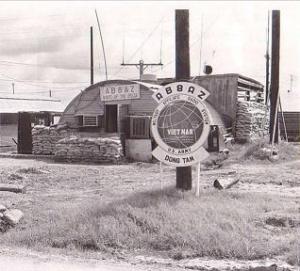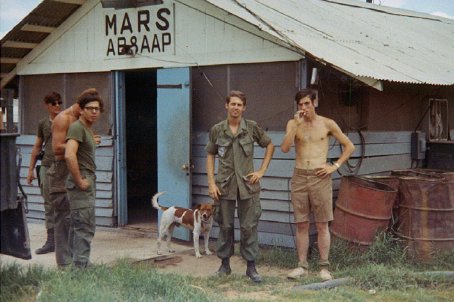- Biển số
- OF-803153
- Ngày cấp bằng
- 23/1/22
- Số km
- 3,310
- Động cơ
- 134,432 Mã lực
- Tuổi
- 49
Mã theo chữ cái chữ không phải số: Hannah xong bấm tiếp Ha Noi






Bác có tài liệu nào xác thực không ạ? Cảm ơn bác.Mã theo chữ cái chữ không phải số: Hannah xong bấm tiếp Ha Noi


Hồi đó sợ chưa có vì Mỹ đt về nhà hay dt sang vẫn dùng kiểu personal radio telephone 5':Giống như nhân viên giới thiệu màu sắc của sơn tường chẳng hạn. Nôm na có thể gọi là màu trắng ngọc trai, trắng ngà voi gì đó nhưng vẫn phải có mã chính xác cho những màu trắng đó.




| STATION | LOCATION(S) | SPONSORING UNITS | YEARS |
|---|---|---|---|
| AB8AB | Qui Nhon | HHD, QNH Sub-Area Command | 66-72 |
| AB8AC | Cam Rahn Bay | C Co 41st signal | 67-68 |
| AB8AD | Di An | 121st Signal Battalion, 1st Infantry Division | 66-70 |
| Kontum | Task Force #2, ADV | 70-72 | |
| AB8AE | An Khe | 509th Signal Battalion | 66-67 |
| An Khe | 41st Signal Battalion, 1st Air Cavalry Division | 67-70 | |
| DaNang | 142nd Trans | 71-73 | |
| AB8AF | Soc Trang | 52nd Signal Battalion | 67-70 |
| Long Binh | USARV Headquarters | 70-73 | |
| AB8AG | Nha Trang | 54th Signal Battalion | 66-73 |
| AB8AH | Phuoc Vinh | 1st Brigade, 1st Infantry Division | 66-69 |
| Bien Hoa | HQ, 11th Armored Cavalry Regiment | 69-70 | |
| New Port (Saigon) | USS LTC Page | 70-72 | |
| AB8AI | Bac Lieu | MACV Advisory Team 51 | 66-69 |
| Ca Mau | MACV Advisory Team 51 | 69-72 | |
| AB8AJ | Cu Chi | 125th Signal Battalion, 25th Infantry Division | 66-71 |
| AB8AK | Phan Rang | 3rd Brigade, 101st Airborne Division | 67-68 |
| Camp Eagle (Hue) | HQ, 1st Brigade. 101st Airborne Div. | 68-71 | |
| Song Be | MACV Advisory Team 28 | 71-73 | |
| AB8AL | Lai Khe/Thu Dau Mot | MACV Advisory Team 70 | 66-71 |
| AB8AM | Bien Hoa | 173rd Airborne Brigade | 66-68 |
| Due Pho (LZ English) | 173rd Airborne Brigade | 68-71 | |
| AB8AN | Can Tho | 13th Aviation Battalion | 66-72 |
| AB8AO | Xuan Loc | MACV Advisory Team 95 | 66-71 |
| Cao Lanh | MACV Advisory Team 84 | 71-72 | |
| AB8AP | Hue City | Special Forces Advisory Group | 66-70 |
| Camp Eagle | MACV Advisory Team 3 | 71 -72 | |
| AB8AQ | Phu Bai | 8th Radio Research Field Station | 66-73 |
| AB8AR | Cam Ranh Bay | 1st Trans Battalion, USNS Corpus Christi | 66-68 |
| Off of Vung Tau | 1st Trans Battalion, USNS Corpus Christi | 68-72 | |
| AB8AS | Pleiku | 4th Infantry Division | 66-70 |
| AB8AT | Co A 53d Signal Bn, II Field Force Vietnam | 66-68 | |
| Long Binh (north) The Plantation | Units of the 25th Infantry Division | 68-70 | |
| AB8AU | Camp Bear Cat / Dong Tam | 9th Signal Battalion, 9th Infantry Division | 66-69 |
| Bien Hoa | HQ, II Field Force, USARV | 69-71 | |
| AB8AU/AZ | MOBILE Unit Traveled throughout AOR | 9th Signal Battalion, 9th Infantry Division | 68-69 |
| AB8AV | Vung Tau | 369th Signal Battalion 36th Evacuation Hospital | 68-71 |
| AB8AW | Nha Trang | HQ, 5th Special Forces Group | 66-71 |
| AB8AX | Hoi An (Hawk Hill) | 196th Light Infantry Brigade | 68-70 |
| AB8AY | Phan Thiet (LZ Betty) | MACV Advisory Team 37 | 67-68 |
| Phan Thiet (LZ Betty) | 3rd Brigade, 101st Airborne Division | 69-70 | |
| Tan Son Nhut (Saigon) | 224th Aviation Battalion | 70-73 | |
| AB8AZ | Dong Tam | 9th Signal Battalion, 9th Infantry Division | 67-69 |
| Phu Bai | 501st Signal Battalion, 101st Airborne Division | 69-71 | |
| AB8AAA | Long Binh | 1st Logistical Command | 68-70 |
| Saigon | Headquarters, MACV | 70-72 | |
| AB8AAB | Bien Hoa | 3rd Brigade, 1st Infantry Division | 68-70 |
| Bao Loc | MAC V Advisory Group | 70-71 | |
| AB8AAC | Bear Cat Mountain | 4th Infantry Division | 68-70 |
| Dau Tieng / Phuoc Vinh | 587th Signal Company for 3rd Brigade 25th Infantry 1968 13th Signal Battalion, 1st Air Cavalry Division | 70-71 | |
| AB8AAD | Chu Lai | 523rd Signal Battalion & 27th Evacuation Hosp & Americal Division | 67-72 |
| AB8AAE | Camp Eagle (Hue) | 501st Signal Company, 101st Airborne Division | 68-71 |
| AB8AAF | Tuy Hoa | 261st Signal Company | 68-71 |
| AB8AAG | Camp Evans (north of Hue) | 1st Air Cavalry Division | 67-68 |
| AB8AAH | Duc Pho | 11th Infantry Brigade | 67-71 |
| AB8AAI | Dong Ha (near DMZ) | Units of 101st Airborne Division & 5th Mech | 69-71 |
| AB8AAJ | Pleiku | 43rd Signal Battalion & 71st Evacuation Hospital | 68-71 |
| AB8AAK | Camp Red Devil (Quang Tri) | 1st Brigade, 5th Infantry Division (Mechanized) | 69-71 |
| AB8AAL | Phu Loi | 520th Transportation Battalion | 69-72 |
| AB8AAM | Pleiku (Camp Frank Jones) | 146th Signal Company | 70-73 |
| AB8AAN | Dalat | 5th Special Forces Advisory Team | 69-72 |
| AB8AAO | Dong Ba Thin | Co. D, 43rd Signal Battalion | 69-72 |
| AB8AAP | Vinh Long | 7th of the 1st Air Cavalry & 164th Aviation Group | 68-71 |
| AB8AAQ | Camp Evans | 3rd Brigade, 101st Airborne Division | 69-72 |
| AB8AAR | Firebase Mace | 199th Light Infantry Brigade | 69-70 |
| AB8AAS | Phu Bai | XXIV Corps HQ & 101st Airborne Division | 69-71 |
| AB8AAT | Da Nang | 37th Signal Bn Compound 69-70 China Beach 71-73 | 68-73 |
| AB8AAU | Phu Lam (near Saigon) | Stratcom HQ, USARV/MACV | 69-73 |
| AB8AAV | Song Be (Phan Rang) | MACV Advisory Team | 69-71 |
| AB8AAW | Cat Lai | MACV Advisory Team | 68-71 |
| AB8USA | Long Binh | Headquarters, USARV | 65-72 |
| Tan Son Nhut (Saigon) | 69th Signal Battalion, USARV | 72-73 | |
| AB8SG | Saigon | U.S. Embassy | 73-75 |

Cháu cũng hóng ạ, bởi vì cháu có thói quen nhìn sự vật theo một chuỗi logic, nếu có một "mắt xích" nào đó có vẻ bị thiêu thiếu gì đó thì sẽ đặt câu hỏi.Em hóng tìm hiểu LS.
Hình như là điện thoại một chiều, chỉ gọi được từ Hà Nội.Bác có tài liệu nào xác thực không ạ? Cảm ơn bác.

Vâng ạ, đó là giọng đọc của nữ phát thanh viên Đài Tiếng nói Việt Nam.Hình như là điện thoại một chiều, chỉ gọi được từ Hà Nội.

Làm sao mà lúc đó Xã hội chủ nghĩa gọi trực tiếp sang Phương Tây được, khác mạng màHình như là điện thoại một chiều, chỉ gọi được từ Hà Nội.

Đúng rồi ạ, hồi đó cái mã 84 chỉ là quy ước thôi, thực tế trình độ kỹ thuật là không thể gọi điện liên quốc gia hai chiều đồng thời song song, chỉ có thể gọi điện vô tuyến từng chiều một.Hồi đó sợ chưa có vì Mỹ đt về nhà hay dt sang vẫn dùng kiểu personal radio telephone 5':
Mợ hỏi em mới search lại thì cách liên lạc hồi đó qua sóng vô tuyến và phải có người ở 2 đầu hỗ trợ kết nối, giờ công nghệ khác quá nhiều rồi.Đúng rồi ạ, hồi đó cái mã 84 chỉ là quy ước thôi, thực tế trình độ kỹ thuật là không thể gọi điện liên quốc gia hai chiều đồng thời song song, chỉ có thể gọi điện vô tuyến từng chiều một.
Chuẩn bác, Lúc đấy chắc chỉ có kênh đặc biệt của chính Phủ mới liên lạc được với nước ngoài mà với khối XHCN chắc mã mấy anh em tự quy định mới nhau. Dân thì gọi ra nước ngoài để làm gì.Làm sao mà lúc đó Xã hội chủ nghĩa gọi trực tiếp sang Phương Tây được, khác mạng mà
ITU là của Phương Tây khi đó
Bác ấy nói đùa ạ. Hannah Hanoi là biệt danh mà lính Mỹ đặt cho một nhóm các nữ phát thanh viên Việt Nam, những người trong Chiến tranh Việt Nam đã thay nhau đọc những thông báo tuyên truyền trên Đài Tiếng nói Việt Nam nhằm kêu gọi lính Mỹ từ bỏ cuộc chiến và đòi quyền được trở về nhà.Làm sao mà lúc đó Xã hội chủ nghĩa gọi trực tiếp sang Phương Tây được, khác mạng mà
ITU là của Phương Tây khi đó
Cháu hỏi chính là chỗ tô đậm ạ.Chuẩn bác, Lúc đấy chắc chỉ có kênh đặc biệt của chính Phủ mới liên lạc được với nước ngoài mà với khối XHCN chắc mã mấy anh em tự quy định mới nhau. Dân thì gọi ra nước ngoài để làm gì.
Cảm ơn bác, cháu lấy luôn ví dụ Triều Tiên và Hàn Quốc hiện nay cho dễ hiểu.Mã vùng điện thoại (theo phân chia của Liên minh Điện báo quốc tế – International Telegraph Union (ITU)
Việt Nam thuộc về vùng 8, gồm các nước Đông Á, trong đó 81 là Nhật, 82 là Hàn Quốc, 84 Việt Nam, 850 là Bắc Triều Tiên, 852 Hongkong, 853 Macau, 855 Campuchia, 856 Lào, 86 Trung Quốc, 866 Đài Loan…
Các vùng khác là:
- Vùng 1 (đầu số bắt đầu bằng số 1) là khu vực Bắc Mỹ. Cả Hoa Kỳ lẫn Canada có mã điện thoại bắt đầu bằng số 1 (mã quốc gia), theo sau đó là “mã vùng” gồm ba chữ số, “mã văn phòng trung tâm” có ba chữ số (hoặc mã trao đổi), và “mã trạm” có bốn chữ số.
- Vùng 2 (đầu số bắt đầu bằng số 2) thuộc về Châu Phi (và 1 số quần đảo), Ví dụ số 20 là Ai Cập, 27 là Nam Phi, số 212 là Ma Rốc, 213 là Algeria, 218 là Libya, 234 là Nigeria…
- Vùng 3,4 thuộc về Châu Âu. Số 30 là Hy Lạp, 31 Hà Lan, 32 Bỉ, 33 Pháp, 34 Tây Ban Nha, 350 Gibraltar, 351 Bồ Đào Nha, 36 Hungary, 39 Ý, 40 Romania, 41 Thụy Sĩ…
- Vùng 5 thuộc về Châu Mỹ (ngoại trừ Bắc Mỹ): 51 Peru, 52 Mexico, 53 Cuba, 54 Argentina, 55 Brazil…
- Vùng 6 thuộc về một số nước Đông Nam Á (ngoại trừ 3 nước Đông Dương) và Châu Đại Dương, đó là 60 Malaysia, 61 Úc, 62 Indonesia, 63 Philippines, 64 New Zealand, 65 Singapore, 66 Thái Lan…
- Vùng 7 thuộc về Nga và các nước láng giềng (thuộc Liên Xô cũ).
- Vùng 9 là các nước còn lại của Châu Á (Nam Á, Trung Á, Tây Á), gồm cả Mông Cổ (976) và Miến Điện (95).
Cảm ơn bác, cháu lấy luôn ví dụ Triều Tiên và Hàn Quốc hiện nay cho dễ hiểu.
Triều tiên là +850
Hàn Quốc là +82
Trước năm 1975.
Việt Nam Cộng hòa là +84
Vậy Việt Nam Dân chủ Cộng hòa là +???